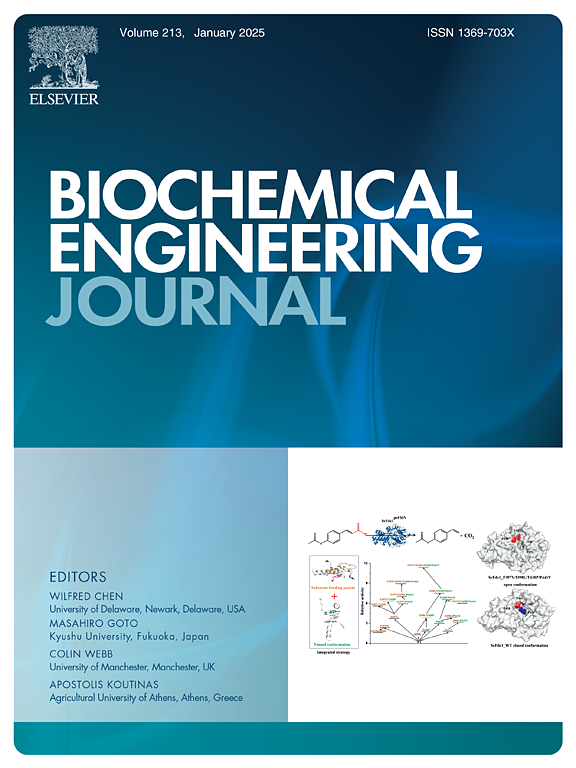Sustainable production of plant biostimulants from cephalosporin fermentation residues: Ultrasonic dissolution and enzymatic hydrolysis
IF 3.7
3区 生物学
Q2 BIOTECHNOLOGY & APPLIED MICROBIOLOGY
引用次数: 0
Abstract
Cephalosporin fermentation residues (CFR) is one of the most challenging industrial organic wastes due to their high nitrogen content. To transform the waste into high-value products, this study explored the effects of various factors on the solubility of total nitrogen (TN) and amino acids (AAs) and the enzymatic hydrolysis characteristics of proteins in CFR and evaluated the bioactivity of the hydrolysates through soybean germination experiments. Results showed that the solubility of AAs and TN reached their peaks at pH = 12 and 50℃, and ultrasonic treatment for 4 h further improved their dissolution. After 24 hours of hydrolysis, the AA yield in the group combining ultrasonication and enzymatic hydrolysis reached 217.5 g/kg dry matter, an 8 % increase compared to the control. The contents of some AAs, such as glutamic acid, phenylalanine, histidine, and arginine, increased by 43–85 % in the hydrolysate. Fluorescence spectroscopy confirmed the release of aromatic amino acids, such as tryptophan and tyrosine, which are known to improve plant stress tolerance. Furthermore, the diluted hydrolysates significantly promoted soybean seed germination under cold and saline conditions (P < 0.05), with the highest germination rates observed at a 1000x dilution. These findings highlight the effectiveness of enzymatic hydrolysis in transforming CFR into plant biostimulants, offering a sustainable solution for agricultural and environmental applications.
从头孢菌素发酵残留物中可持续生产植物生物刺激素:超声波溶解和酶水解
头孢菌素发酵废渣(CFR)因其高氮含量而成为最具挑战性的工业有机废物之一。为了将其转化为高价值产品,本研究通过大豆发芽实验,探讨了各种因素对CFR中总氮(TN)和氨基酸(AAs)的溶解度以及蛋白质的酶解特性的影响,并对水解产物的生物活性进行了评价。结果表明:AAs和TN的溶解度在pH = 12和50℃时达到峰值,超声处理4 h进一步提高了它们的溶出度。水解24 h后,超声与酶解组合组AA得率达到217.5 g/kg干物质,比对照组提高了8 %。水解液中谷氨酸、苯丙氨酸、组氨酸和精氨酸等部分氨基酸的含量提高了43 ~ 85% %。荧光光谱证实了芳香氨基酸的释放,如色氨酸和酪氨酸,它们被认为可以提高植物的抗逆性。此外,稀释后的水解产物在低温和盐水条件下显著促进了大豆种子的萌发(P <; 0.05),稀释1000倍时的发芽率最高。这些发现强调了酶水解将CFR转化为植物生物刺激素的有效性,为农业和环境应用提供了可持续的解决方案。
本文章由计算机程序翻译,如有差异,请以英文原文为准。
求助全文
约1分钟内获得全文
求助全文
来源期刊

Biochemical Engineering Journal
工程技术-工程:化工
CiteScore
7.10
自引率
5.10%
发文量
380
审稿时长
34 days
期刊介绍:
The Biochemical Engineering Journal aims to promote progress in the crucial chemical engineering aspects of the development of biological processes associated with everything from raw materials preparation to product recovery relevant to industries as diverse as medical/healthcare, industrial biotechnology, and environmental biotechnology.
The Journal welcomes full length original research papers, short communications, and review papers* in the following research fields:
Biocatalysis (enzyme or microbial) and biotransformations, including immobilized biocatalyst preparation and kinetics
Biosensors and Biodevices including biofabrication and novel fuel cell development
Bioseparations including scale-up and protein refolding/renaturation
Environmental Bioengineering including bioconversion, bioremediation, and microbial fuel cells
Bioreactor Systems including characterization, optimization and scale-up
Bioresources and Biorefinery Engineering including biomass conversion, biofuels, bioenergy, and optimization
Industrial Biotechnology including specialty chemicals, platform chemicals and neutraceuticals
Biomaterials and Tissue Engineering including bioartificial organs, cell encapsulation, and controlled release
Cell Culture Engineering (plant, animal or insect cells) including viral vectors, monoclonal antibodies, recombinant proteins, vaccines, and secondary metabolites
Cell Therapies and Stem Cells including pluripotent, mesenchymal and hematopoietic stem cells; immunotherapies; tissue-specific differentiation; and cryopreservation
Metabolic Engineering, Systems and Synthetic Biology including OMICS, bioinformatics, in silico biology, and metabolic flux analysis
Protein Engineering including enzyme engineering and directed evolution.
 求助内容:
求助内容: 应助结果提醒方式:
应助结果提醒方式:


